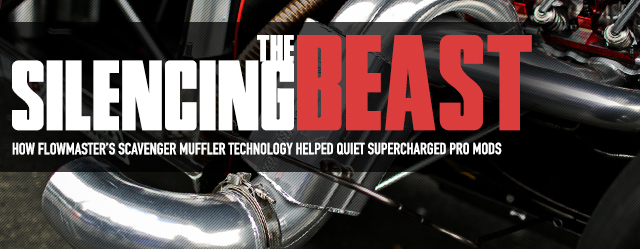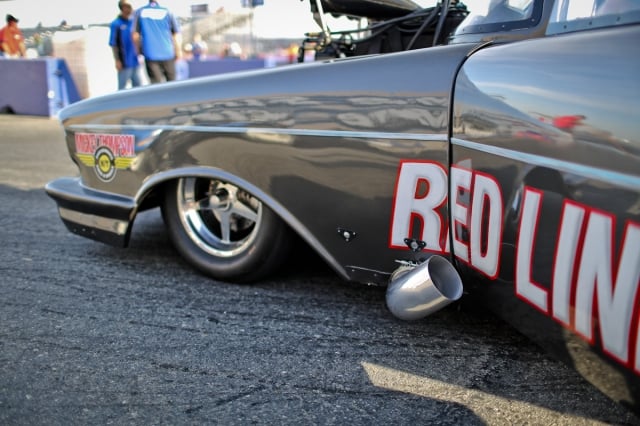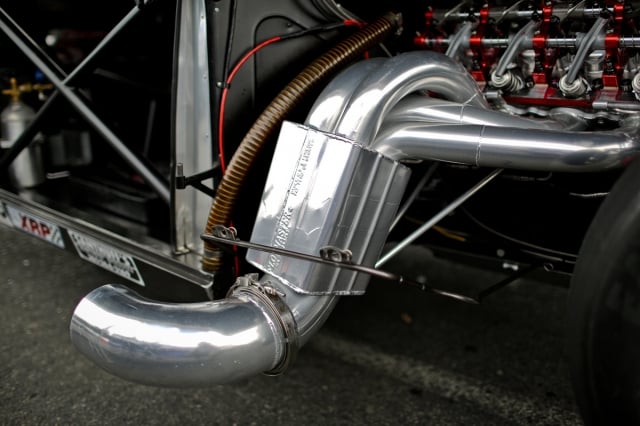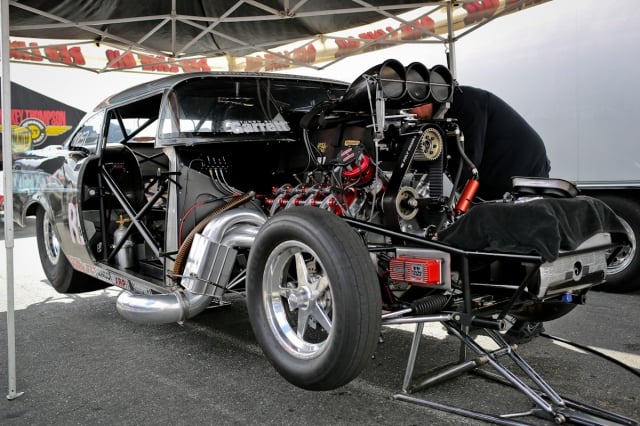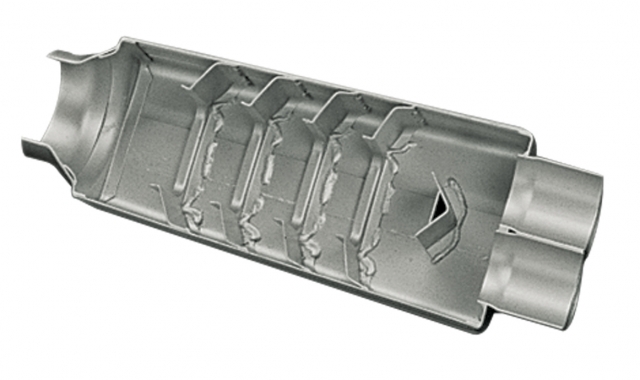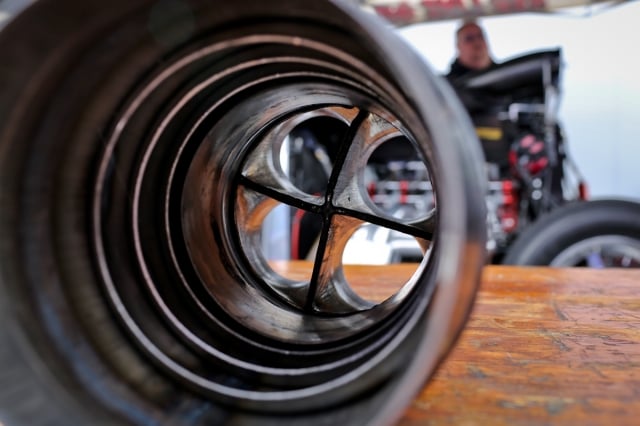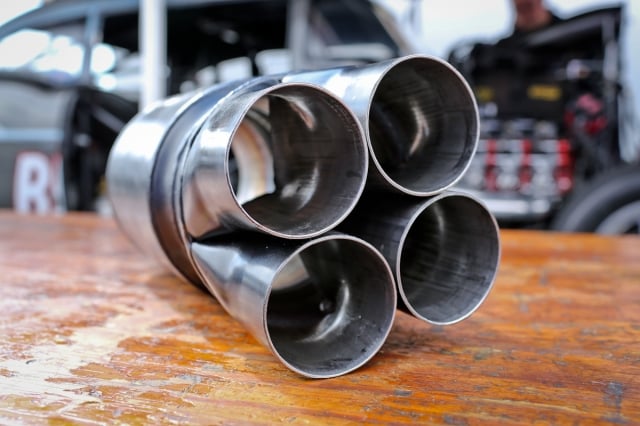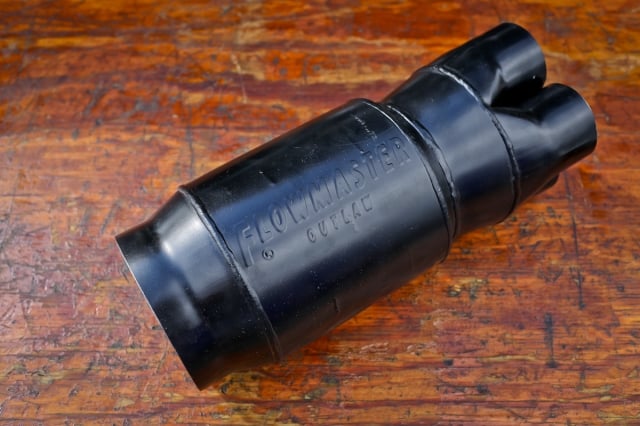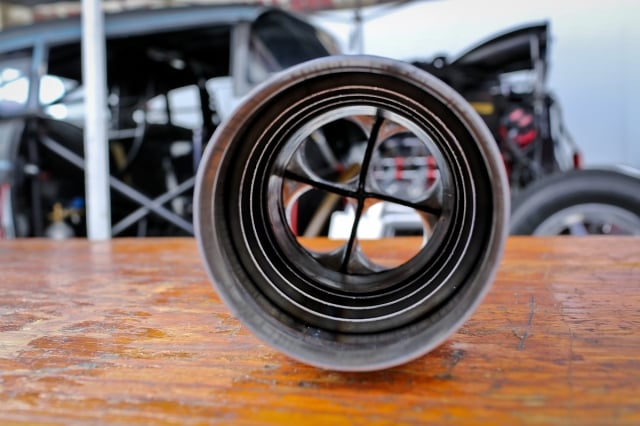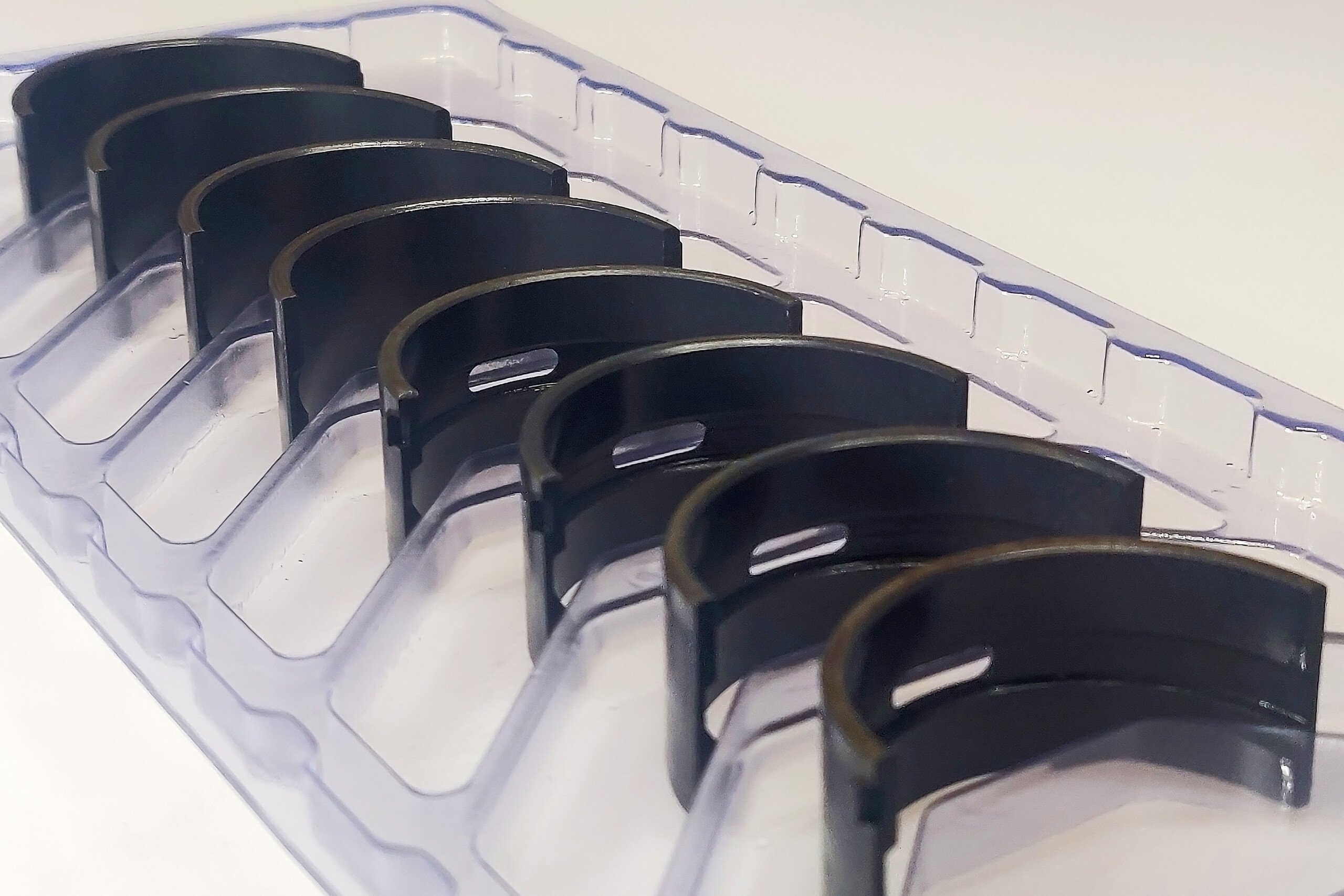Keeping the sound levels emitted by a high performance or racing engine in check while retaining every last drop of horsepower and torque has been the mission of exhaust manufacturers like Flowmaster for decades. Just as racers and race teams have continued to push the boundaries of performance, so too have the exhaust companies, who have expanded the technology built into their mufflers by leaps and bounds. In turn they deliver a product that not only excels in the sound department, but actually produces horsepower, rather than restricting.
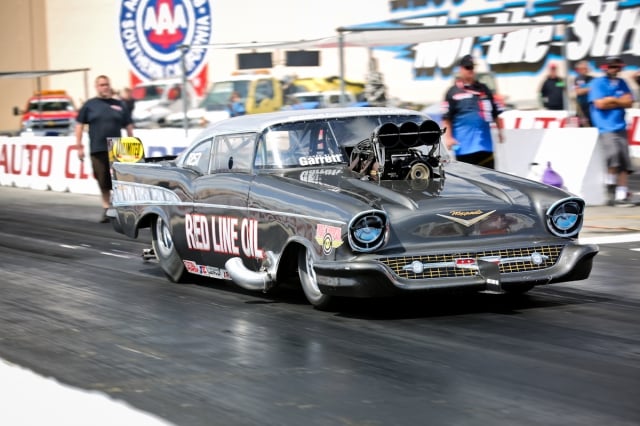
Veteran West coast Pro Modified racer John Scialpi was one of four supercharged racers to take part in a test at the Auto Club Dragway in February, where his zoomie-equipped Chevrolet registered 92-93 decibels, well over the 85 dB limit.
The team at Flowmaster recently had the opportunity to showcase the abilities of their scavenger muffler technology at the upper echelons of drag racing. They were called upon to help roots-blown Pro Modified racers with the NMCA WEST series gain approval for competition at the Auto Club Dragway in Fontana, California, where a very strict new ordinance on decibel levels had recently been enacted. Simply put, if the racers couldn’t maintain fewer than 85 decibels as recorded at a specific location in a nearby residential neighborhood, they wouldn’t be allowed to compete. This measurement was taken, according to Scialpi, on Cherry Avenue at the end of the strip, and a location 1,000 feet north of the new full-length sound wall, which was mandated to help reduce the sound outside the confines of the facility.
And it was NMCA WEST regular and veteran Pro Modified racer John Scialpi, with every intention of challenging for the series title, who stepped up to the plate to find a solution.
Decibel Testing
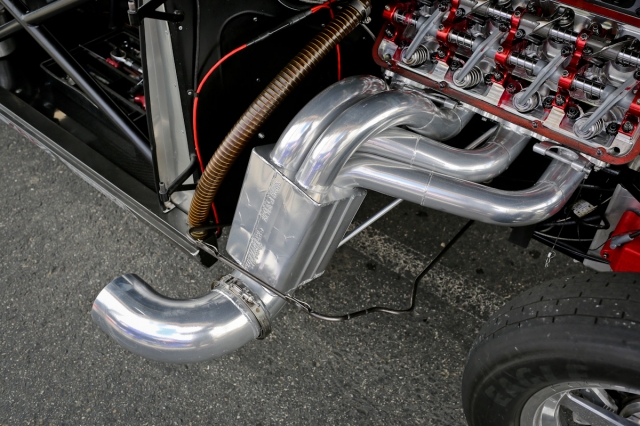
After entertaining a number of ideas and trying a few mufflers that Flowmaster had sent over, Scialpi settled on the Scavenger collector muffler. He returned to the track two weeks later and passed the test with flying colors.
As Scialpi told us, he along with fellow West coast Pro Mod racer Mike Maggio (who runs a screw blower), beside a pair of supercharged nostalgia A/Gas cars, were invited out by the track and the NMCA to a test, doing burnouts and short launches to see where the decibel levels fell. His roots-blown Chevrolet registered roughly 93 to 94 dB, while Maggio’s was slightly higher in the 96 to 97 dB range. With a failing grade in-hand the NMCA tech staff and Scialpi turned to Flowmaster for assistance.
“The NMCA contacted us and said John wanted to race at Fontana, but the blown cars couldn’t pass any of the sound requirements,” said Flowmaster’s Ronnie Olson. “So we got with John and started working on a solution. It was a huge task in the beginning, dealing with a car that’s 2,500 horsepower and equipped with zoomies, but we did a couple of experiments and sent some mufflers out to him to see if they’d fit on the car. As it turned out, he ended up using a pair of our original Scavenger mufflers that we’ve had for years. They work very well, and they aren’t an experimental muffler by any means. But that’s what he ended up making the decibel limit with.”
The guys at Flowmaster, at first, didn’t think the Scavenger collector mufflers would quiet it enough with as many decibels as we had to go to reach 85, but I think the adjustable turn-back exhaust exit that we made helped it some, too. – John Scialpi
“The guys at Flowmaster at first didn’t think the Scavenger collector mufflers would quiet it enough with as many decibels as we had to go to reach 85, but I think the adjustable turn-back exhaust exit that we made helped it some, too,” said Scialpi. “I had an old set of collector-style headers laying around from my old car, and we cut the collector off and put the Scavenger muffler on there and made them work.”
As Olson shared with us, during the NMCA WEST’s season-opening race, Scialpi’s car actually registered as low as 78 dB at times, although he and Scialpi both indicate that the wind and the presence of trailer lining the track, along with other factors, can tend to effect those readings. According to Scialpi, the highest reading during the event was 81 dB, a difference he says was made by the full pit and spectator arming shrouding the sound to the south.
The Science Behind Flowmaster’s Scavenger Muffler
To understand how Flowmaster is able to provide that kind of sound dampening without a loss of performance, you have to better understand how the Scavenger mufflers have been designed. As Flowmaster’s Nick Tauber told us, there are two distinct things to look at with this muffler design, and the primary element of the design is the scavenging.
Flowmaster's Scavenger Mufflers
In this cutaway image, you can gain a better understanding of how the Scavenger race muffler works. As incoming exhaust gases enter the muffler, it’s split in half by the deflector, before coming back together and striking the strategically-placed ‘ribs’ in the muffler, effectively canceling out the sound waves. At the same time, a low pressure area is created that pulses the exhaust gases, which creates a pulling — or “scavenging” — effect on the gases from the exhaust port, thereby creating horsepower.
“Mufflers deal with sound, and with exhaust pulses,” Tauber continues. “After that initial sound cancellation takes place, the multiple ribs that are engineered into the muffler take the exhaust wave from the engine and force the sound waves back together again, and cancel each other out. But from the physical exhaust pulse standpoint — not the sound standpoint — you have this pulse, and when it splits apart and comes back together, there’s a small low pressure area that builds up behind that deflector and helps pull the exhaust through the system. It’s almost like a miniature tornado.”
This scavenging effect, as Tauber points out, pulls the exhaust through the muffler, and that action is how the muffler, in many applications, can actually help produce horsepower, not hamper it.
The number of ribs inside the muffler, and their very exacting and strategic location — machined down to .032-inch tolerances — determines whether the scavenging effect works or doesn’t work, Tauber told us. And as he went to on to say, “A well-tuned exhaust will definitely help you make horsepower.”
A Lot To Gain And Little to Lose
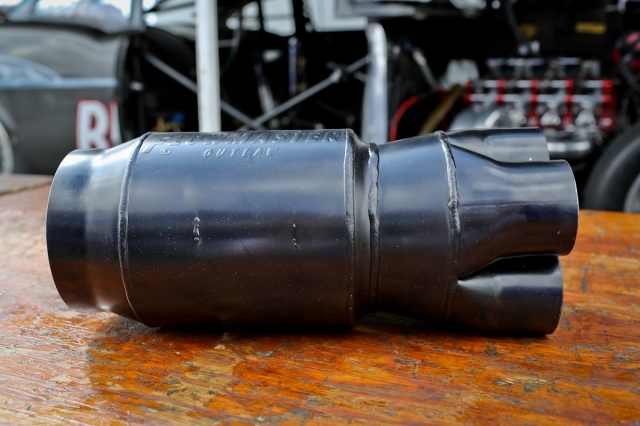
Flowmaster’s second-generation Scavenger Outlaw II race muffler, a brand new muffler that’s still in the testing phase, incorporates the same fundamental concepts of the Scavenger collector muffler in a more compact package.
“We had some good success with Scialpi’s car at the first race — it was fast, it was doing what it needed to do, and it’s going to get better throughout the year,” said Olson. “Hopefully more people will see that just because the car has mufflers on it doesn’t automatically make him slow. He was still very competitive.”
Flowmaster has supplied Scialpi with a brand new muffler in their lineup, a second-generation part known as the Scavenger Outlaw II, that will be tested in the coming weeks to determine if it also provides adequate sound dampening and performance.
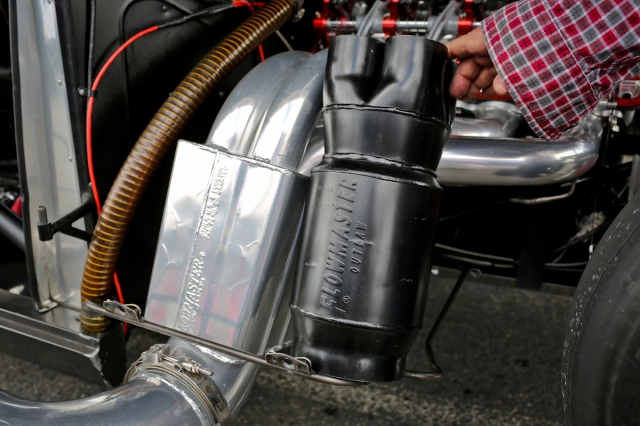
Here you can see the difference between the Scavenger collector muffler and the new Outlaw II. In the case of the Scavenger (on the car), Scialpi has modified the muffler to fit by cutting off the collector section at the inlet and welding the header pipes directly to the muffler case.
As Scialpi shared with us, the new Outlaw II offers a little less restriction than the Scavenger collector muffler, and although that means it may come in a few decibels louder, he feels there’s enough ‘wiggle’ room to stay under the mark. The new Outlaw II, which Tauber describes as the further advancement of Flowmaster’s craft, takes the basic fundamental concept of the Scavenger muffler and converts it into a smaller, more compact and appealing package that accomplishes the very same tasks.
Said Olson, “We’re planning to continue testing and developing the Outlaw II and we hope we can eventually pass that on to all racers. For all the of the guys running the zoomies, they’re eventually going to have to go back to the conventional four-into-one style exhaust. Some racers have suggested they run the zoomies because the crowd enjoys the sound, but I try to explain to them that turbocharged and nitrous racers are just as quick but run quieter, proving that the fans are really into the speeds more than anything.”
“It’s not always about the sound, and we really need to calm that down so that we can avoid more situations like what the Auto Club Dragway had with their neighbors. At some point, you’re going to have to do it.”
Here's another look at the new Outlaw II, which features the same deflector and 'ribs' as the Scavenger muffler seen above, but accomplishes it using a very different-looking design.
Scialpi indicated that the difference in noise level inside the cockpit was quite significant, suggesting as much as half of the sound was cancelled out with the use of the mufflers. And as he learned in conversing with spectators over the course of that first outing, “Everybody liked how it sounded — they told me it was the best sounding car out there,” Scialpi told us.
It’s not always about the sound, and we really need to calm that down so that we can avoid more situations like what the Auto Club Dragway had with their neighbors. At some point, you’re going to have to do it. – Ronnie Olson
Olson and the team at Flowmaster believe they’ve made some great headway in a short amount of time in helping racers like John Scialpi to gain approval under the narrow guidelines, and in furthering the message that mufflers aren’t a bad thing for hardcore drag racers. In the end, it’s about making race cars eligible to continue doing what they were intended to do, regardless of how they sound, and that’s to race.
Olson, Tauber, and everyone at Flowmaster truly believe that, with the muffler technology available today, there’s nothing to lose and a lot to gain by running them.



